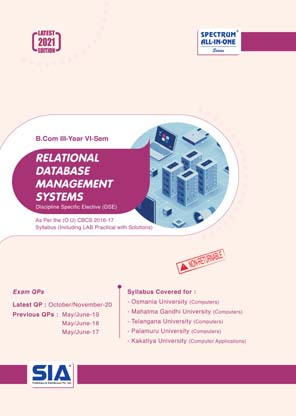

Note: Please check your Spam or Junk folder, in case you didn't receive the email with verification code.
SYLLABUS
Unit–I
Basic concepts Database Management System – File Based System – Advantages of DBMS Over File Based System – Database Approach – Logical DBMS Architecture – Three Level Architecture of DBMS or Logical DBMS Architecture – Need for Three level Architecture – Physical DBMS Architecture – Database Administrator (DBA) Functions and Role – Data Files Indices and Data Dictionary – Types of Database – Relational and ER Models: Data Models – Relational Model – Domains – Tuple and Relation – Super Keys – Candidate Keys – Primary Keys and Foreign Keys for the Relations – Relational Constraints – Domain Constraint – Key Constraint – Integrity Constraint – Update Operations and Dealing with Constraint Violations – Relational Operations – Entity Relationship (ER) Model – Entities – Attributes – Relationships – More about Entities and Relationships – Defining Relationship for College Database – E-R Diagram – Conversion of E-R Diagram to Relational Database.
Unit–II
Database integrity and normalization Relational Database Integrity – The Keys – Referential Integrity – Entity Integrity – Redundancy and Associated Problems – Single Valued Dependencies – Normalisation – Rules of Data Normalisation – The First Normal Form – The Second Normal Form – The Third Normal Form – Boyce Codd Normal Form – Attribute Preservation – Lossless–join Decomposition – Dependency Preservation, File Organisation : Physical Database Design Issues – Storage of Database on Hard Disks – File Organisation and Its Types – Heap Files (Unordered Files) – Sequential File Organisation – Indexed (Indexed Sequential) File Organisation – Hashed File Organisation – Types of Indexes – Index and Tree Structure – Multi-key File Organisation – Need for Multiple Access Paths – Multi–list File Organisation – Inverted File Organisation.
Unit–III
Structures query language (sql) Meaning – SQL Commands – Data Definition Language – Data Manipulation Language – Data Control Language – Transaction Control Language – Queries using Order – by Where – Group by – Nested Queries, Joins – Views – Sequences – Indexes and Synonyms – Table Handling.
Unit–IV
Transactions and concurrency management Transactions – Concurrent Transactions – Locking Protocol – Serialisable Schedules – Locks Two Phase Locking (2PL) – Deadlock and its Prevention – Optimistic Concurrency Control, Database Recovery and Security, Database Recovery meaning – Kinds of Failures – Failure Controlling Methods – Database Errors – Backup and Recovery Techniques – Security and Integrity – Database Security – Authorization.
Unit–V
Distributed and client server databases Need for Distributed Database Systems – Structure of Distributed Database – Advantages and Disadvantages of DDBMS – Advantages of Data Distribution – Disadvantages of Data Distribution – Data Replication – Data Fragmentation, Client Server Databases: Emergence of Client Server Architecture – Need for Client Server Computing – Structure of Client Server System and its Advantages.
 No Preview is available for this book
No Preview is available for this book

 Get 100 instant uPoints on the purchase of Rs.100 or above for each order.
Get 100 instant uPoints on the purchase of Rs.100 or above for each order.
CategoriesArts and Science

Format PDF

TypeeBook